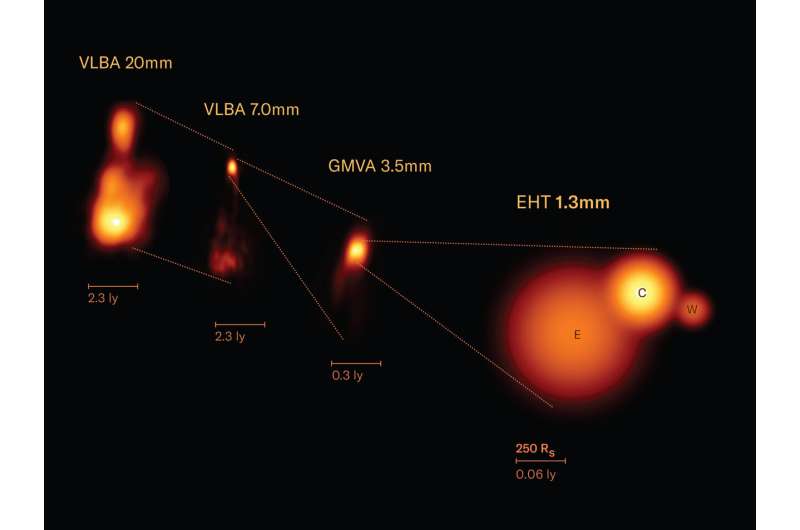Radio image of the galaxy 3C 84 showing the black hole jet in the centre at different spatial scales (denoted by the horizontal bar below each image), with the EHT image on the right exhibiting the most details. Credit: Georgios Filippos Paraschos (MPIfR)
The Event Horizon Telescope collaboration, including scientists from the Max Planck Institute for Radio Astronomy in Bonn, Germany, has recently resolved the jet base of an evolving jet of plasma at ultra-high angular resolution.
The international team of scientists used the Earth-size telescope to probe the magnetic structure in the nucleus of the radio galaxy 3C 84 (Perseus A), one of the closest active supermassive black holes in our cosmic neighborhood.
These novel results provide new insight into how jets are launched, revealing that in this cosmic tug of war, the magnetic fields overpower gravity. The study is published in the journal Astronomy & Astrophysics.
The strong radio source 3C 84 or Perseus A corresponds to NGC 1275, the central galaxy in the Perseus cluster at a distance of 230 million light years. It hosts a relatively nearby active galactic nucleus, allowing for a detailed investigation of the central source at high resolution with the Event Horizon Telescope (EHT).
"Besides providing first images of black holes, the EHT is supremely suitable to observe astrophysical jets of plasma and their interplay with strong magnetic fields," says Georgios Filippos Paraschos, researcher at the Max Planck Institute for Radio Astronomy (MPIfR), who led the project. "Our new findings provide new evidence that an ordered magnetic field extends throughout the heated gas enveloping the black hole."
The groundbreaking observations made by the EHT enable the scientists to address enduring questions regarding the process by which black holes accrete matter and eject powerful jets, reaching distances beyond their host galaxies.
In recent years, the Event horizon Telescope has unveiled images showing the direction of the light oscillation around the M 87* black hole. This property of the emitted light, called linear polarization, provides clues about the underlying magnetic field. In particular, strong linear polarization, as found in the present study, hints at a strong, well-ordered magnetic field in the 3C 84 black hole vicinity.
Notably, such powerful magnetic fields are thought to be the driving force behind the launching of such plasma jets, consisting of matter that was not consumed by the black hole.
"The radio galaxy 3C 84 is particularly interesting for the challenges it presents in detecting and accurately measuring the polarization of light near its black hole," notes Jae-Young Kim, associate professor for astrophysics at Kyungpook National University (Daegu, South Korea), also affiliated with the MPIfR. "The Event Horizon Telescope's exceptional capability to penetrate the dense, interstellar gas marks a groundbreaking advancement for precisely observing the vicinity of black holes."
Such high-precision observations pave the way for discovering and studying other supermassive black holes that have remained hidden and elusive to previous observational technologies.
More information: G. F. Paraschos et al, Ordered magnetic fields around the 3C 84 central black hole, Astronomy & Astrophysics (2024). DOI: 10.1051/0004-6361/202348308
Provided by Max Planck Society























